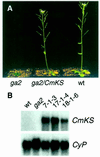The GA2 locus of Arabidopsis thaliana encodes ent-kaurene synthase of gibberellin biosynthesis
- PMID: 9536043
- PMCID: PMC35033
- DOI: 10.1104/pp.116.4.1271
The GA2 locus of Arabidopsis thaliana encodes ent-kaurene synthase of gibberellin biosynthesis
Abstract
The ga2 mutant of Arabidopsis thaliana is a gibberellin-deficient dwarf. Previous biochemical studies have suggested that the ga2 mutant is impaired in the conversion of copalyl diphosphate to ent-kaurene, which is catalyzed by ent-kaurene synthase (KS). Overexpression of the previously isolated KS cDNA from pumpkin (Cucurbita maxima) (CmKS) in the ga2 mutant was able to complement the mutant phenotype. A genomic clone coding for KS, AtKS, was isolated from A. thaliana using CmKS cDNA as a heterologous probe. The corresponding A. thaliana cDNA was isolated and expressed in Escherichia coli as a fusion protein. The fusion protein showed enzymatic activity that converted [3H]copalyl diphosphate to [3H]ent-kaurene. The recombinant AtKS protein derived from the ga2-1 mutant is truncated by 14 kD at the C-terminal end and does not contain significant KS activity in vitro. Sequence analysis revealed that a C-2099 to T base substitution, which converts Gln-678 codon to a stop codon, is present in the AtKS cDNA from the ga2-1 mutant. Taken together, our results show that the GA2 locus encodes KS.
Figures





Similar articles
-
The Arabidopsis GA1 locus encodes the cyclase ent-kaurene synthetase A of gibberellin biosynthesis.Plant Cell. 1994 Oct;6(10):1509-18. doi: 10.1105/tpc.6.10.1509. Plant Cell. 1994. PMID: 7994182 Free PMC article.
-
Molecular cloning and characterization of a cDNA encoding the gibberellin biosynthetic enzyme ent-kaurene synthase B from pumpkin (Cucurbita maxima L.).Plant J. 1996 Aug;10(2):203-13. doi: 10.1046/j.1365-313x.1996.10020203.x. Plant J. 1996. PMID: 8771778
-
The LS locus of pea encodes the gibberellin biosynthesis enzyme ent-kaurene synthase A.Plant J. 1997 Mar;11(3):443-54. doi: 10.1046/j.1365-313x.1997.11030443.x. Plant J. 1997. PMID: 9107034
-
Ent-kaurene synthase from the fungus Phaeosphaeria sp. L487. cDNA isolation, characterization, and bacterial expression of a bifunctional diterpene cyclase in fungal gibberellin biosynthesis.J Biol Chem. 1997 Aug 29;272(35):21706-12. doi: 10.1074/jbc.272.35.21706. J Biol Chem. 1997. PMID: 9268298
-
Emission of ent-kaurene, a diterpenoid hydrocarbon precursor for gibberellins, into the headspace from plants.Plant Cell Physiol. 2004 Sep;45(9):1129-38. doi: 10.1093/pcp/pch149. Plant Cell Physiol. 2004. PMID: 15509835
Cited by
-
Formation of the unusual semivolatile diterpene rhizathalene by the Arabidopsis class I terpene synthase TPS08 in the root stele is involved in defense against belowground herbivory.Plant Cell. 2013 Mar;25(3):1108-25. doi: 10.1105/tpc.112.100057. Epub 2013 Mar 19. Plant Cell. 2013. PMID: 23512856 Free PMC article.
-
Cloning of DOG1, a quantitative trait locus controlling seed dormancy in Arabidopsis.Proc Natl Acad Sci U S A. 2006 Nov 7;103(45):17042-7. doi: 10.1073/pnas.0607877103. Epub 2006 Oct 25. Proc Natl Acad Sci U S A. 2006. PMID: 17065317 Free PMC article.
-
Conserved bases for the initial cyclase in gibberellin biosynthesis: from bacteria to plants.Biochem J. 2019 Sep 24;476(18):2607-2621. doi: 10.1042/BCJ20190479. Biochem J. 2019. PMID: 31484677 Free PMC article.
-
Two rings in them all: the labdane-related diterpenoids.Nat Prod Rep. 2010 Nov;27(11):1521-30. doi: 10.1039/c0np00019a. Epub 2010 Oct 1. Nat Prod Rep. 2010. PMID: 20890488 Free PMC article. Review.
-
The tomato terpene synthase gene family.Plant Physiol. 2011 Oct;157(2):770-89. doi: 10.1104/pp.111.179648. Epub 2011 Aug 3. Plant Physiol. 2011. PMID: 21813655 Free PMC article.
References
-
- Aach H, Böse G, Graebe JE. ent-Kaurene biosynthesis in a cell-free system from wheat (Triticum aestivum L.) seedlings and the localisation of ent-kaurene synthetase in plastids of three species. Planta. 1995;197:333–342.
-
- Ait-Ali T, Swain SM, Reid JB, Sun T-p, Kamiya Y. The LS locus of pea encodes the gibberellin biosynthesis enzyme ent-kaurene synthase A. Plant J. 1997;11:443–454. - PubMed
-
- Altschul SF, Gish W, Miller W, Myers E, Lipman DJ. Basic local alignment search tool. J Mol Biol. 1990;215:403–410. - PubMed
-
- Bechtold N, Ellis J, Pelletier G. In planta Agrobacterium mediated gene transfer by infiltration of adult Arabidopsis thaliana plants. CR Acad Sci Paris. 1993;316:1194–1199.
-
- Bensen RJ, Zeevaart JAD. Comparison of ent-kaurene synthetase A and B activities in cell-free extracts from young tomato fruits of wild-type and gib-1, gib-2 and gib-3 tomato plants. J Plant Growth Regul. 1990;9:237–242.
MeSH terms
Substances
Associated data
- Actions
LinkOut - more resources
Full Text Sources
Molecular Biology Databases
Research Materials
Miscellaneous

